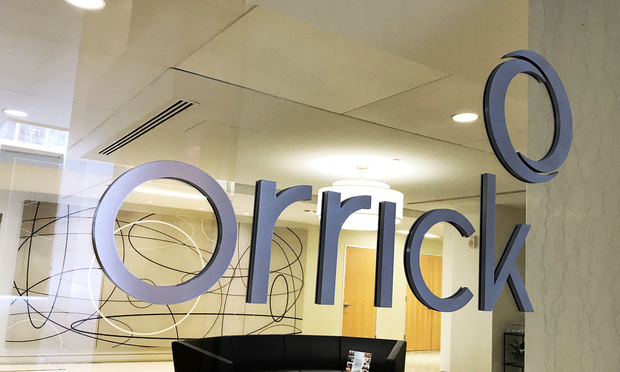'Crazy Ideas' Welcome: How Orrick Is Working to Build an Innovation Culture
The firm is one year into a program that allows associates to put 50 hours of billing credit towards innovation projects.
June 17, 2019 at 05:00 AM
5 minute read
 Photo: Diego M. Radzinschi/ALM
Photo: Diego M. Radzinschi/ALM
Orrick, Herrington & Sutcliffe has worked to make innovation a fundamental part of its brand in recent years.
It can point to successes along the way: In December, The American Lawyer honored Orrick as an innovation leader at its first industry awards, citing the firm's legal technology venture Orrick Labs. But in embracing innovation, the firm has been forced to confront the risk-aversion that's fundamental to the practice of law.
“People are so conservative about what can be done,” said Orrick chief talent officer Siobhan Handley. Advances and breakthroughs tend to require enduring failures and embracing uncertainty—pretty much the opposite of what lawyers strive for.
“We're rules-following individuals,” Handley said.
One strategy for trying to change the mindset of attorneys across the firm has been a program, launched last June, that allows associates 50 hours of creditable time a year towards innovation projects. Orrick isn't alone in the idea: Reed Smith piloted a similar project in 2017 for a limited number of associates and removed a cap on the number of projects that would be approved in 2018.
While the Orrick associates interested in participating also have to put together a proposal, chief innovation officer Wendy Curtis emphasized that the bar is not high.
“Sometimes you just have a hunch and need the opportunity to think about that hunch,” she said. “It doesn't need to be perfect, but it needs to be something that we can track to a client need in the firm.”
The goal is introduce the mindset that innovation—and the “crazy ideas and failures that are not going to get anywhere”—should still be part of the “everyday approach” of all the firm's lawyers, according to Handley.
“This is particularly resonating with the millennial generation, which is inherently entrepreneurial and wants this kind of freedom in everything they touch,” she said.
Curtis acknowledged that they had to tinker with the program on the fly after it was launched.
“A part of having a good innovation culture is a willingness to constantly improve,” she said. “When we did this, we were overwhelmed by the number of ideas. We very quickly had to find a way to vet them.”
As part of that effort, the firm attached a second user interface to its portal, “The Observatory,” which was originally built to provide an overview of the technology tools available in the market. The additional interface offers a look at innovation projects currently underway at the firm—as well as ideas that had been considered and then rejected.
➤➤ Need a hand keeping pace with law firm innovation? Sign up for daily or weekly alerts from Law.com. Follow Innovation
Ideas In Practice
Boston associate Nick Farnsworth received the go-ahead from the firm to take part in developing a readiness tool to aid clients with the California Consumer Privacy Act.
Farnsworth, a member of the firm's cyber, privacy and data innovation team, recognized that with the number of laws and regulations pertaining to data collection multiplying, there was growing confusion in the marketplace.
“Some people are trying to get fast summaries without digging too deeply into the statutory requirements,” Farnsworth said.
The tool that he helped develop offers clients a dynamic questionnaire that collects the characteristics of their company and provides a detailed description of how they will be affected by the CCPA and how prepared they are.
“It's not so much on the legal analysis side, but what the facts are and comparing them with what the facts should be,” he said.
Farnsworth worked with a team of developers from an early stage to shape the tool. He said that he initially thought it would be necessary to go outside the firm for expertise, but that proved to be unnecessary.
“I didn't realize how deep our bench was on the tech side,” he said.
Beyond Apps
But Curtis emphasized that innovation does not automatically equal technology, While some associates have been working on apps and similar tools, and some even bring software development backgrounds to the table, others have found different ways to participate in the initiative.
San Francisco senior associate Rebecca Harlow helped put together an “innovation sprint” for in-house litigation attorneys at Chevron Corp., a client of the firm.
“We facilitated the session for them, to help them come up with the craziest ideas they could in 45 minutes to improve how they could do their work and leverage the work,” she said.
The firm also uses a similar approach for its own lawyers and staff, implementing internal hackathons. “Once they start writing down the bad ideas, you will start to see them becoming more comfortable with the good ideas,” Handley said.
Beyond her surprise at how effective the “sprint” model was in particular in generating new ideas, Harlow came away from the experience intrigued about leveraging it for other clients.
“From the business development side, it's great as an associate to get in front of a client not pitching, but just brainstorming,” she said. “Having done it once, I'd like to do it again externally.”
Read More
Orrick Passes $1B Revenue Benchmark as Footprint Grows
Orrick Chair Mitch Zuklie on Law Firm Skunkworks, Talent Wars and What's Ahead
This content has been archived. It is available through our partners, LexisNexis® and Bloomberg Law.
To view this content, please continue to their sites.
Not a Lexis Subscriber?
Subscribe Now
Not a Bloomberg Law Subscriber?
Subscribe Now
NOT FOR REPRINT
© 2025 ALM Global, LLC, All Rights Reserved. Request academic re-use from www.copyright.com. All other uses, submit a request to [email protected]. For more information visit Asset & Logo Licensing.
You Might Like
View All
White & Case Crosses $4M in PEP, $3B in Revenue in 'Breakthrough Year'
6 minute read
Lawyers Across Political Spectrum Launch Public Interest Team to Litigate Against Antisemitism
4 minute read

Jones Day Names New Practice Leaders for Antitrust, Business and Tort Litigation and Latin America
Trending Stories
- 1States Accuse Trump of Thwarting Court's Funding Restoration Order
- 2Microsoft Becomes Latest Tech Company to Face Claims of Stealing Marketing Commissions From Influencers
- 3Coral Gables Attorney Busted for Stalking Lawyer
- 4Trump's DOJ Delays Releasing Jan. 6 FBI Agents List Under Consent Order
- 5Securities Report Says That 2024 Settlements Passed a Total of $5.2B
Who Got The Work
J. Brugh Lower of Gibbons has entered an appearance for industrial equipment supplier Devco Corporation in a pending trademark infringement lawsuit. The suit, accusing the defendant of selling knock-off Graco products, was filed Dec. 18 in New Jersey District Court by Rivkin Radler on behalf of Graco Inc. and Graco Minnesota. The case, assigned to U.S. District Judge Zahid N. Quraishi, is 3:24-cv-11294, Graco Inc. et al v. Devco Corporation.
Who Got The Work
Rebecca Maller-Stein and Kent A. Yalowitz of Arnold & Porter Kaye Scholer have entered their appearances for Hanaco Venture Capital and its executives, Lior Prosor and David Frankel, in a pending securities lawsuit. The action, filed on Dec. 24 in New York Southern District Court by Zell, Aron & Co. on behalf of Goldeneye Advisors, accuses the defendants of negligently and fraudulently managing the plaintiff's $1 million investment. The case, assigned to U.S. District Judge Vernon S. Broderick, is 1:24-cv-09918, Goldeneye Advisors, LLC v. Hanaco Venture Capital, Ltd. et al.
Who Got The Work
Attorneys from A&O Shearman has stepped in as defense counsel for Toronto-Dominion Bank and other defendants in a pending securities class action. The suit, filed Dec. 11 in New York Southern District Court by Bleichmar Fonti & Auld, accuses the defendants of concealing the bank's 'pervasive' deficiencies in regards to its compliance with the Bank Secrecy Act and the quality of its anti-money laundering controls. The case, assigned to U.S. District Judge Arun Subramanian, is 1:24-cv-09445, Gonzalez v. The Toronto-Dominion Bank et al.
Who Got The Work
Crown Castle International, a Pennsylvania company providing shared communications infrastructure, has turned to Luke D. Wolf of Gordon Rees Scully Mansukhani to fend off a pending breach-of-contract lawsuit. The court action, filed Nov. 25 in Michigan Eastern District Court by Hooper Hathaway PC on behalf of The Town Residences LLC, accuses Crown Castle of failing to transfer approximately $30,000 in utility payments from T-Mobile in breach of a roof-top lease and assignment agreement. The case, assigned to U.S. District Judge Susan K. Declercq, is 2:24-cv-13131, The Town Residences LLC v. T-Mobile US, Inc. et al.
Who Got The Work
Wilfred P. Coronato and Daniel M. Schwartz of McCarter & English have stepped in as defense counsel to Electrolux Home Products Inc. in a pending product liability lawsuit. The court action, filed Nov. 26 in New York Eastern District Court by Poulos Lopiccolo PC and Nagel Rice LLP on behalf of David Stern, alleges that the defendant's refrigerators’ drawers and shelving repeatedly break and fall apart within months after purchase. The case, assigned to U.S. District Judge Joan M. Azrack, is 2:24-cv-08204, Stern v. Electrolux Home Products, Inc.
Featured Firms
Law Offices of Gary Martin Hays & Associates, P.C.
(470) 294-1674
Law Offices of Mark E. Salomone
(857) 444-6468
Smith & Hassler
(713) 739-1250










